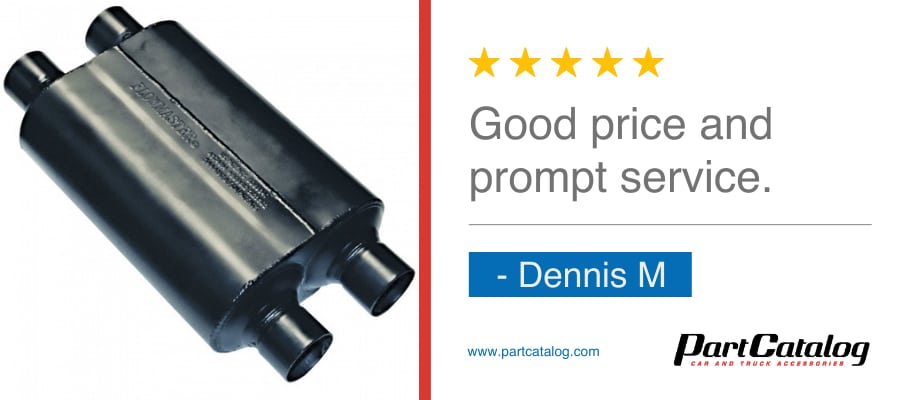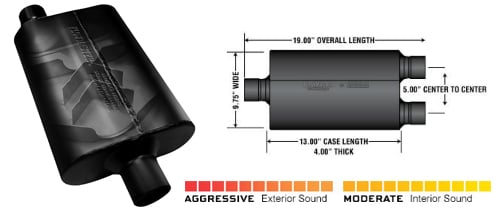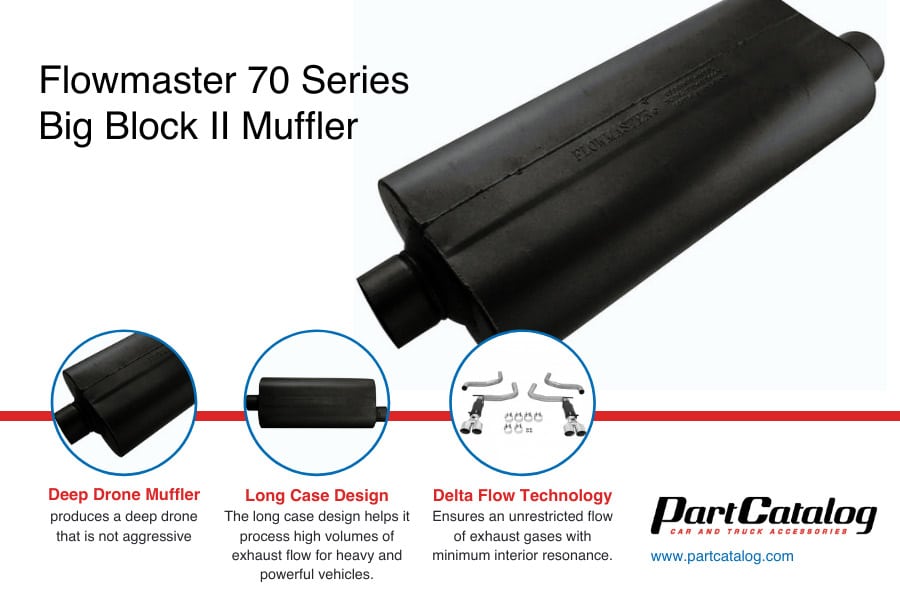The 40 Series mufflers are among the original designs of Flowmaster products. They have the signature sound that most Flowmaster fans recognize and love.
You may have unique needs and might be looking for a muffler with specific quality and performance.
Are these mufflers suitable for you? Can they deliver the satisfaction you’re looking for?
Here are the features of the 40 Series Flowmaster that’ll optimize your driving experience.
- Aggressive Exhaust Sound
- Several Inlet and Outlet Designs
- High-Quality Construction Material
- Easy Installation
- Average Size
- The 40 Series Flowmaster Mufflers: Quick Specs
- Comparing 40 Series to Other Flowmaster Mufflers
- Frequently Asked Questions
- What Are the Different Series of Flowmaster Mufflers?
- Chambered Versus Free Flow Muffler: Which One Is better?
- Aftermarket Versus Stock Mufflers: Which Ones Should I Choose?
- How Does a High-Performance Muffler Sound?
- How Do Mufflers Work?
- What Is an Exhaust Drone?
- How Do I Know My Vehicle Needs Muffler Replacement?
- Does a Loud Exhaust Consume More Fuel?
Aggressive Exhaust Sound
When upgrading your exhaust system, you may want a quieter or a louder muffler.
The 40 Series Flowmaster mufflers are not for guys with sensitive ears. They get loud during a cold start and acceleration.
They also have an aggressive tone that’s audible even from the inside of your vehicle.
Why?
They’re dual-chambered.
A Flowmaster muffler is either single, double, or triple-chambered—the fewer the chambers, the louder the exhaust sounds.
The original 40 Series also lacks the Delta Flow technology found in other Flowmaster series, resulting in a fierce exhaust roar because of the discharge noise.

Several Inlet and Outlet Designs
The 40 Series Flowmaster mufflers are available in different inlet and outlet designs.
Depending on your vehicle’s exhaust system, here’s what you’ll get in this series:
- A center inlet muffler with dual outlet

- An offset inlet and center outlet muffler

- Offset inlet and offset outlet muffler

High-Quality Construction Material
The 40 series mufflers are available in two options—409 stainless or aluminized steel.
Stainless steel is durable and resistant to rust and corrosion, while aluminized steel is lighter, perfect for dry climates, and more affordable.
Stainless steel mufflers have a limited lifetime warranty, while their aluminized counterpart has a 3-year limited warranty.
The materials are MIG (Metal Inert Gas) welded for premium quality with zero leakages.
Easy Installation
The 40 Series mufflers are vehicle-specific and easy to install.
If you need a single or dual tailpipe or double muffler for your ride, you can quickly get it.
You can also choose from 3.00, 2.25, or 2.5 inches muffler inlet and outlet diameters, depending on your vehicle model and your engine’s horsepower.
In short, just select what fits your vehicle specifications for easy installation.
Average Size
The muffler’s size affects its performance in terms of exhaust system backpressure and sound. A smaller muffler is louder than a larger one.
The 40 Series Flowmaster mufflers are average in size, producing an aggressive exhaust sound.
Most have an overall length of 19 inches with the dimensions of 4 × 9.75 ×13 inches (H × W × L).

The 40 Series Flowmaster Mufflers: Quick Specs
- Original Flowmaster mufflers
- Available in aluminized and stainless steel
- Aggressive exterior and interior tone
- MIG welded for durability
- Aluminized steel mufflers come with a 3-year limited warranty
- Stainless steel mufflers come with a limited lifetime warranty
Comparing 40 Series to Other Flowmaster Mufflers
Flowmaster has several muffler series. How does the 40 Series compare to some popular ones?
The Super 40 Series
The Super 40 Series is a modified version of the original 40 Series, hence its more profound and richer exhaust sound.
They’re dual-chambered, made of aluminized steel, and equipped with Delta flow.
Delta flow is a noise-canceling technology that reduces the noise inside the car while having an aggressive exterior sound.

The Super 40 have spaced baffles that separate sound waves inside the muffler.
The baffles reroute the waves and force them to re-collide at a precise angle, canceling each other out and reducing the unwanted noise.
The Super 44 Series
The Super 44 Flowmaster mufflers are slightly louder than the standard and Super 40 Series.
They’re equipped with Delta Flow technology that eliminates the exhaust drone (present in the original 40 Series), giving them a cleaner sound.
The Super 44 mufflers are double-chambered and made of 409 stainless steel, making them highly durable.

The Delta Flow 40 Series
As the name suggests, these mufflers have the Delta Flow technology that reduces the discharge noise at an advanced level.
They have a toned-down sound and are more moderate than the Super 44, Original, and Super 40 Series. If you’re after a loud muffler, this option might not be for you.
They’re dual-chambered and available in aluminized and stainless steel, making them highly durable.

The table below summarizes the comparison of the four Flowmaster muffler series:
| Flowmaster Muffler Series | Interior Tone | Exterior Tone | Construction Material | Delta Flow Technology |
| Original 40 Series | Aggressive | Aggressive |
Aluminized steel Stainless steel |
No |
| Super 40 Series | Moderate | Aggressive | Aluminized steel | Yes |
| Super 44 Series | Moderate | Aggressive | Stainless steel | Yes |
| Delta Flow 40 Series | Moderate | Aggressive |
Aluminized steel Stainless steel |
Yes |
Frequently Asked Questions
What Are the Different Series of Flowmaster Mufflers?
There are 13 series in total:
- Outlaw Series
- Super 10
- Super 44
- Super 40
- 40 Series
- Delta Flow 40
- 80 Series
- 50 Series HD
- DBX Series
- Super HP2
- Pro Series
- Delta 50
- 60 Series
Chambered Versus Free Flow Muffler: Which One Is better?
It depends on the exhaust sound you’re looking for.
Chambered mufflers have a series of baffles that direct exhaust gases into chambers, tuning the exhaust sounds into a deep, powerful, bassy pitch.
Hence, they have a more pleasant sound.
Free flow mufflers, on the other hand, direct exhaust gases through a perforated central tube. With no baffles to reduce the speed of gases, free flow mufflers can’t tune exhaust sounds, making them loud.
If you want a tuned exhaust sound, go for a chambered muffler. But if you’re looking for a loud exhaust, a free-flow muffler will suit you.

Aftermarket Versus Stock Mufflers: Which Ones Should I Choose?
It depends on the muffler performance you want.
Stock mufflers are restrictive since the OEM makes them with more focus on affordability than performance.
On the other hand, aftermarket mufflers focus on better performance, making them an upgrade to your exhaust system.
They make your vehicle sound more aggressive by producing deep exhaust growls.
The stock mufflers will suit you if you don’t mind the exhaust sounds. But if the sound matters, you’ll never go wrong with a well-tuned aftermarket muffler.
How Does a High-Performance Muffler Sound?
The sound of a high-performance muffler can be anything from a low, ear-splitting roar to a tuned, throaty growl.
The aim is to get pleasant exhaust tones and avoid loud, unpleasant sounds.
How Do Mufflers Work?
After fuel combustion, the engine expels exhaust gases as high-pressure pulses that create a powerful sound wave. Mufflers reduce the power of these sound waves.
Depending on the design, a muffler uses chambers, baffles, perforated tubes, or other sound-canceling material to reduce exhaust gas noise.

What Is an Exhaust Drone?
It’s the annoying vibrations a vehicle’s engine and exhaust system create at a specific RPM.
As opposed to the well-tuned rumble of a stock or aftermarket exhaust, the exhaust drone has an unnatural resonance that makes it unpleasant.
How Do I Know My Vehicle Needs Muffler Replacement?
You’ll know your vehicle needs muffler replacement when you notice:
- Excess noise from your exhaust system
- Muffler leakages that may result from rusting and corrosion
- Engine problems
Does a Loud Exhaust Consume More Fuel?
No. Fuel consumption isn’t related to the exhaust sound.
The heaviness of the exhaust tone depends on the muffler you install, which determines the sound-reducing property of your exhaust system.
